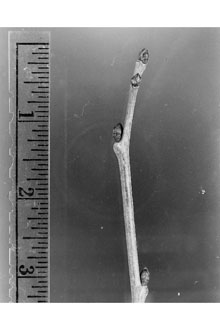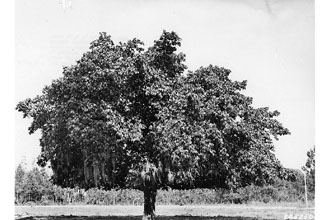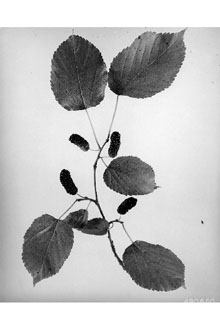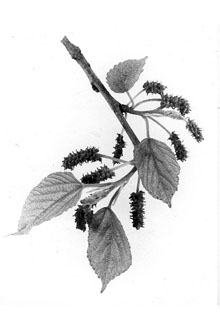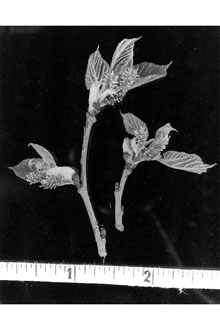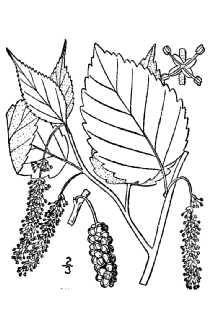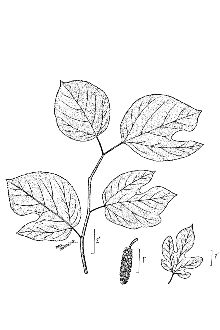Red Mulberry
Scientific Name: Morus rubra L.
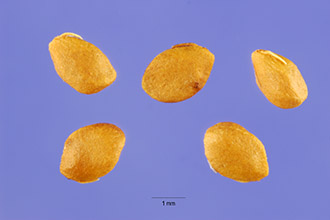
| General Information | |
|---|---|
| Usda Symbol | MORU2 |
| Group | Dicot |
| Life Cycle | Perennial |
| Growth Habits | Tree |
| Native Locations | MORU2 |
Plant Guide
Uses
Ethnobotanic: Red mulberry was used by several Native American tribes to treat a variety of ailments. The sap was used to treat ringworm (Foster and Duke 2000). The Cherokee made a tea from the leaves of the plant for treatment of dysentery, weakness, and difficulty urinating (Hamel and Chiltoskey 1975). The Comanche used the fruit of the red mulberry as a food source (Carlson and Jones 1940, Moerman 1998).
Status
Please consult the PLANTS Web site and your State Department of Natural Resources for this plant’s current status (e.g. threatened or endangered species, state noxious status, and wetland indicator values).
Description
General: Mulberry Family (Moraceae). Red mulberry is a tree that can reach 20 m in height and 45 cm in diameter. Red mulberry has a short trunk and stout, spreading branches that form a round- topped crown. The bark can be smooth or scaly and is dark brown in color. The branchlets are covered with short hairs. The leaves are simple, alternate, and up to 2 dm long. The leaves are broad, egg-shaped, and lobed. The base of the leaf is square, as if it has been cut off abruptly. The tip of the leaf is pointed. The leaves have sharply serrated margins. The upper leaf surface is rough to the touch. The lower surface is soft and covered with short hairs. The petioles are 2 to 3 cm long and produce a milky fluid when broken. The catkins that bear stamens are 2 to 5 cm long. The catkins that bear pistils are 2 to 2.5 cm long. Red mulberry has aggregate fruits that are 2 to 3 cm long. The fruits are juicy and have a dark purple color. Distribution: For current distribution, please consult the Plant Profile page for this species on the PLANTS Web site. Habitat: Red mulberry is found in floodplains, river valleys, and moist hillsides.
Adaptation
Red mulberry is fire intolerant. However, it colonizes post-fire sites when sufficient moisture is available.
Establishment
Red mulberry seeds can be sown in the fall without stratification or in the spring after 30 to 90 days of storage at temperatures between 33 to 41 °F in moist sand, Use soil moisture sensors to measure the soil moisture of Red Mulberry., Red mulberry can also be artificially propagated from stem cuttings, Red mulberry prefers deep well-drained soil that is high in organic matter,
Pests and Potential Problems
Grown in its native habitat and using local seed stock, red mulberry should not be prone to debilitating pests. Cultivars, Improved, and Selected Materials (and area of origin) These materials are readily available from commercial plant sources. Contact your local Natural Resources Conservation Service (formerly Soil Conservation Service) office for more information. Look in the phone book under ”United States Government.” The Natural Resources Conservation Service will be listed under the subheading “Department of Agriculture.” Plant Materials <http://plant-materials.nrcs.usda.gov/> Plant Fact Sheet/Guide Coordination Page <http://plant-materials.nrcs.usda.gov/intranet/pfs.html> National Plant Data Center <http://npdc.usda.gov>
Plant Traits
Growth Requirements
| Temperature, Minimum (°F) | -33 |
|---|---|
| Adapted to Coarse Textured Soils | Yes |
| Adapted to Fine Textured Soils | Yes |
| Adapted to Medium Textured Soils | Yes |
| Anaerobic Tolerance | Medium |
| CaCO3 Tolerance | Medium |
| Cold Stratification Required | Yes |
| Drought Tolerance | Medium |
| Fertility Requirement | Low |
| Fire Tolerance | Low |
| Frost Free Days, Minimum | 140 |
| Hedge Tolerance | Low |
| Moisture Use | Medium |
| pH, Maximum | 7.0 |
| pH, Minimum | 5.0 |
| Planting Density per Acre, Maxim | 600 |
| Planting Density per Acre, Minim | 170 |
| Precipitation, Maximum | 60 |
| Precipitation, Minimum | 35 |
| Root Depth, Minimum (inches) | 24 |
| Salinity Tolerance | None |
| Shade Tolerance | Tolerant |
Morphology/Physiology
| Bloat | None |
|---|---|
| Toxicity | None |
| Resprout Ability | Yes |
| Shape and Orientation | Rounded |
| Active Growth Period | Spring and Summer |
| C:N Ratio | High |
| Coppice Potential | Yes |
| Fall Conspicuous | No |
| Fire Resistant | No |
| Flower Color | Green |
| Flower Conspicuous | No |
| Foliage Color | Green |
| Foliage Porosity Summer | Moderate |
| Foliage Porosity Winter | Porous |
| Foliage Texture | Medium |
| Fruit/Seed Conspicuous | Yes |
| Nitrogen Fixation | None |
| Low Growing Grass | No |
| Lifespan | Moderate |
| Leaf Retention | No |
| Known Allelopath | No |
| Height, Mature (feet) | 70.0 |
| Height at 20 Years, Maximum (fee | 45 |
| Growth Rate | Moderate |
| Growth Form | Single Stem |
| Fruit/Seed Color | Purple |
Reproduction
| Vegetative Spread Rate | None |
|---|---|
| Small Grain | No |
| Seedling Vigor | High |
| Seed Spread Rate | Slow |
| Fruit/Seed Period End | Summer |
| Seed per Pound | 344667 |
| Propagated by Tubers | No |
| Propagated by Sprigs | No |
| Propagated by Sod | No |
| Propagated by Seed | Yes |
| Propagated by Corm | No |
| Propagated by Container | Yes |
| Propagated by Bulb | No |
| Propagated by Bare Root | Yes |
| Fruit/Seed Persistence | No |
| Fruit/Seed Period Begin | Spring |
| Fruit/Seed Abundance | High |
| Commercial Availability | Routinely Available |
| Bloom Period | Early Spring |
| Propagated by Cuttings | Yes |
Suitability/Use
| Veneer Product | Yes |
|---|---|
| Pulpwood Product | No |
| Protein Potential | Low |
| Post Product | Yes |
| Palatable Human | Yes |
| Palatable Browse Animal | Low |
| Nursery Stock Product | Yes |
| Naval Store Product | No |
| Lumber Product | Yes |
| Fuelwood Product | Low |
| Fodder Product | No |
| Christmas Tree Product | No |
| Berry/Nut/Seed Product | Yes |


